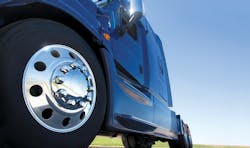After fuel, tires are among the largest costs of operation for fleets. As simple as it sounds, properly maintaining tires can save you money while improving performance.
To maximize tire life and reduce wear, you need to manage a range of factors, including tire-wheel fit, inflation pressure, rotation practices, vehicle loading and more.
Tire Fitting
Let’s start with fitting the tire to a wheel/rim. Although three standards organizations govern tire-rim interaction, the most common rim contour standards in North America come from the Tire and Rim Association (www.us-tra.org). It defines a minimum contour for a rim size and describes which tires will fit those given contours.
You can tell which contour you are using by looking at the letter after the DOT stamp on your wheel. For example, if the letter is a “T” (“DOT T”), then the contour is from the Tire and Rim Association (TRA).
Tires that do not fit the rims properly can pose a safety threat. Improper fit can lead to premature wear of the tread and wheel rim flange, air leaks and even the tire creeping over the flange.
Inflation
The easiest way to get the maximum life out of your tires is to keep them properly inflated. Make it a habit to check your tire pressure weekly. Without proper inflation, tires can’t perform as you expect them to when making turns, braking and acceleration.
The ideal time to do this is when the tires are cold, typically before you begin the driving day.
But how much pressure is enough? Leading tire manufacturers provide tables that will help you set proper inflation pressures for various loads.
Too Much or Too Little Air
Overinflation can make for an uncomfortable ride and cause irregular tire wear. Underinflation must be avoided, as well, because it causes tread to wear unevenly – especially at tire edges – while reducing durability and increasing fuel consumption.
Underinflation also causes the sidewall to flex, generating more heat that could lead to premature wear and even tire failure.
Components such as braking systems also apply heat to the wheels that gets transferred to the tires. Typically, aluminum wheels dissipate heat faster than steel, reducing the transfer of heat from the brake system to tires.
A good rule of thumb is to check tire pressure with a calibrated tire gauge. For frequent checks, go for the precision that tire pressure monitoring systems (TPMS) afford.
Up the food chain, automatic tire inflation systems (ATIS) maintain your tires at uniform pressure, thus maximizing tire life, lowering maintenance costs and boosting fuel economy by about 1 percent. ATIS systems keep tire pressures stable despite changes in altitude, driving conditions, air temperature and other factors that alter tire inflation.
Truck tires that aren’t properly monitored and maintained can lose up to 2 psi per month of inflation pressure simply as a result of air molecules diffusing through sidewalls.
Abrasion Happens
Grit, dirt and other abrasive contaminants can get trapped near the bead seat of the tire and the flange of the wheel. As tires flex, these abrasive contaminants gradually wear away at the wheel. This condition is most noticeable with aluminum wheels because they are softer.
Flange wear affects steel wheels, too, but their hardness slows the pace of erosion.
Abrasion on aluminum wheels eventually can cause valleys to form on the flange with sharp edges capable of wearing and cutting the sidewall or bead of the tire. Left unchecked, this can render the tire unusable.
It is a common practice to file the sharp edges away. Afterward, check them using the wheel manufacturer’s flange-wear gauge to verify TRA flange standards.
If your wheel does not pass this test in any area, remove it from service.
Accuride recently introduced its Accu-Flange aluminum wheel treatment that reinforces the rim flange area in order to reduce rim flange wear often seen in heavy-haul, shifting-load and frequent stop-start applications. Accu-Flange is available for multiple part numbers and finish combinations.
Additional Impacting Factors
Sometimes, defective valves allow air leaks to occur, so it is important to keep valves and grommets in proper working order. Using metal caps and keeping them tightened can prevent debris from getting inside the valve mechanism and causing a leak.
Take the time to properly inspect these components when changing tires.
Regular rotation, too, can extend tire life. Scheduled tire rotations using a cross pattern deliver the best results for minimizing uneven tire wear.
In dual applications, it is important to check tire inflation and overall wheel/tire size to ensure that tread patterns and depths are similar. Any significant difference in outside tire diameters will cause uneven wear and an overloading situation on one tire/wheel assembly. Check with your tire manufacturer for details.
Just like your diet, proper balance in your wheel-tire combination will extend tire life. Follow manufacturer-recommended match mounting procedures (low point of wheel with high point of tire) to ensure a properly runout tire/wheel assembly.
Furthermore, tire manufacturers have specific procedures and recommendations for tread wear measurement and tire disposal. Be sure to follow these recommended maintenance practices to achieve maximum tire life and performance.
Craig Kessler is vice president of engineering at Accuride Corporation (www.accuridecorp.com), a leading supplier of components to the North American commercial vehicle industry.
About the Author
Craig Kessler
Vice President, Engineering, Accuride Corporation
Craig Kessler is vice president of engineering at Accuride Corporation (www.accuridecorp.com), a leading supplier of components to the North American commercial vehicle industry.
